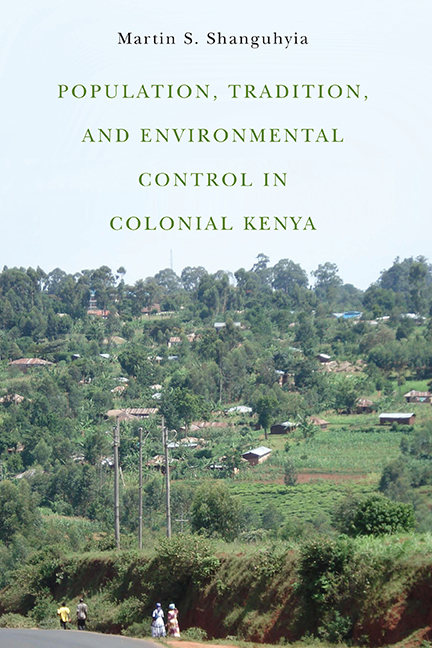Book contents
- Frontmatter
- Contents
- List of Illustrations
- Preface
- Abbreviations
- Introduction
- 1 Administrative and Demographic Changes: Implications on Land Relations, 1900–1930
- 2 Maize and Economic Prosperity, 1920–38
- 3 Internationalizing Degradation Narratives in Kenya, 1930–38
- 4 Prewar Soil Conservation Initiatives and Local Responses, 1934–38
- 5 Wartime Production in a Besieged Environment, 1939–45
- 6 Postwar Development and the Dilemma of “Reviving” African Traditions, 1945–63
- 7 Regional Migration and Failed Agricultural Intensification, 1940–66
- Conclusion
- Notes
- Bibliography
- Index
7 - Regional Migration and Failed Agricultural Intensification, 1940–66
Published online by Cambridge University Press: 09 June 2021
- Frontmatter
- Contents
- List of Illustrations
- Preface
- Abbreviations
- Introduction
- 1 Administrative and Demographic Changes: Implications on Land Relations, 1900–1930
- 2 Maize and Economic Prosperity, 1920–38
- 3 Internationalizing Degradation Narratives in Kenya, 1930–38
- 4 Prewar Soil Conservation Initiatives and Local Responses, 1934–38
- 5 Wartime Production in a Besieged Environment, 1939–45
- 6 Postwar Development and the Dilemma of “Reviving” African Traditions, 1945–63
- 7 Regional Migration and Failed Agricultural Intensification, 1940–66
- Conclusion
- Notes
- Bibliography
- Index
Summary
Introduction
During the 1940s, and particularly the 1950s, colonial population narratives that addressed Vihiga's dilemmas in agricultural development became more refined than they had been in the previous decades. Those narratives also formed the core of solutions that were suggested for Vihiga's rural challenges. This chapter seeks to show that high population densities and scarcity of land in Vihiga during the 1940s and 1950s were real problems known to colonial officials. Yet solutions that were intended to relieve the area of population pressure and promote meaningful agricultural development failed because those remedies proved contradictory and unsustainable. This exacerbated decline, rather than increased prosperity, in local agricultural enterprises. The agricultural sector, which had raised Vihiga to a position of prominence in Kenya's colonial economy only thirty years back, became a shadow of its former self in this area's search for local economic alternatives.
For much of the postwar period, the administration conceptualized Vihiga's problem as a “demographic” one requiring both agricultural and nonagricultural solutions. Agricultural solutions involved discouraging farmers from pursuing the production of maize, already declining rapidly because of loss of soil fertility and ever-decreasing farm sizes. Farmers were required to shift to the cultivation of coffee, considered to be a high-value cash crop. The nonagricultural solutions that were consistently suggested involved transforming the area into a rural landless proletariat reserve exporting labor to other parts of Kenya and resettling surplus population in other parts of Kenya and across colonial boundaries into Tanganyika and Uganda. These nonagricultural solutions, especially out-migration, were probably a permanent option for this area. While consistently part of official policy, this option received inadequate support from the government, and it was left for peasant households to explore on their own. Out-migration from Vihiga created regional agricultural diasporas, especially in the Maragoli community, across colonial borders in Tanganyika and Uganda.
Agricultural problems found solutions in the agricultural intensification that the government pushed within leading agricultural reserves in Kenya. In Vihiga, intensification took the form of land consolidation and highly restricted coffee cultivation, which achieved minimal success. Leading up to and after independence, the area progressed along a path of wagelabor employment, amid population increase and land scarcity. As a result, Vihiga remains one of the most densely populated rural areas in Africa dependent on subsistence agriculture and with persistent unemployment that challenges the modern development efforts of the area.
- Type
- Chapter
- Information
- Publisher: Boydell & BrewerPrint publication year: 2015



